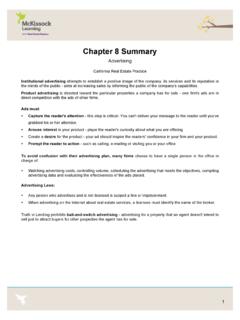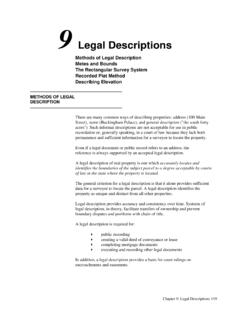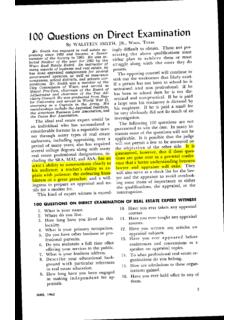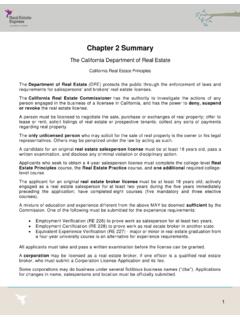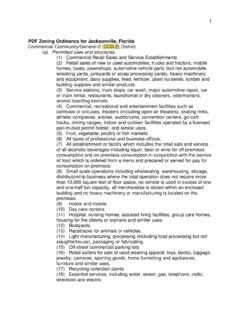Transcription of INTRODUCTION
1 1 INTRODUCTIONIn this Unit, you will learn about California and why it is called the Golden State. You will look at how California s diverse population affects its economic base, sustains the state s economic growth, and how the state s economy influences the national economy. Finally, we will touch on the brokerage business and opportunities in the real estate ObjectivesAfter completing this Unit, you should be able to: 1A recall the unique characteristics of California s climate and geography. 1B characterize California s multicultural demographics. 1C indicate factors contributing to California s economy and housing IN CALIFORNIAL ocation! Location! Location! Most of you have seen this phrase in a real estate ad describing the perfect neighborhood. All of you reading this, no matter what city you live in, are experiencing the perfect location.
2 2 California Real Estate Principlesare not referring to your specific street, town or are talking about California. California has everything, and usually it is the best! Whoever said, Less is more just never lived in s natural and man-made wonders can only be described with superlatives. California s economy is so large that it actually competes with countries not just states. Additionally, it is the first state to ever reach a trillion-dollar economy in gross state product. At over 38 million people, California is the most culturally diverse and the most populous state in the country, and has been since 1962. In fact, one out of every eight United States residents lives in California. California is called The Golden State. Some say it is due to its long association with gold mining made famous by the Gold Rush.
3 Others point to the golden grasses that cover our hills in the summer and fall, or the fields of golden poppies that bloom in the springtime. You might call California golden because of our fabulous, golden sunshine and warm climate. In any event, gold has been intertwined with the history and development of and GeographyWhere but California could you surf in the morning, play 18 holes of golf, and then enjoy a torch-lit night ski run all in the same day? California is a beautiful place, blessed with phenomenal natural beauty and a climate free from hurricanes, tornadoes, and blizzards. We definitely enjoy a relatively mild basic climate is called Mediterranean, characterized by general sun and warmth with rain mainly in the winter. Of course, there are variations based on the distance from the ocean and the elevation.
4 Average rainfall varies from 80 inches in Del Norte County (north coast) to as low as 3 inches in Imperial County (desert).California has a relatively mild climate Unit 1 California s Diversity 3We have five main zones : coastal, desert, foothill, valley, and climate is characterized by mild temperatures with minor annual variations. Most of the state s population lives along the climate is characterized by high summer temperatures, extremely low humidity, and very little rainfall. Valley climate is characterized by high temperatures and low humidity in the summer and low temperature and high humidity in the winter. Both the Sacramento and San joaquin Valleys have this weather pattern. 4 California Real Estate PrinciplesMountain climate is the only area that gets heavy snow in the winter. Winters are very cold and summers are bright and sunny.
5 Foothill climate (1,000 to 3,000 feet in elevation) is similar to the valley regions but with more rain and less is the third largest state in land area (158,693 square miles) with 1,264 miles of coastline and an average width of 175 miles. We have everything here: beautiful beaches, deserts, valleys, foothills, towering mountains, and even a delta with are still three active volcanoes in California. In the Cascade Mountain Range are Mt. Lassen (elevation 10,457 feet) and Mt. Shasta (elevation 14,162 feet). Mt. Mammoth (elevation 11,000 feet) is located in the Sierra Nevada Mountain THE PEOPLE MAGNETC alifornia, with its mild climate and seemingly unending opportunities, continues to draw immigrants today just as it did 150 years ago. We shouldn t be surprised. A recent Harris Poll conducted online among a nationwide Unit 1 California s Diversity 5cross section of adults, showed that Americans would like to live here than in any other state.
6 They were asked, If you could live in any state in the country, except the state you live in now, what state would you choose to live in? California was the first choice with Florida second and Hawaii CaliforniaCalifornia was already inhabited by Native Americans in villages and tribes when early explorers touched our coastline and made new claims for foreign countries. Portuguese-born Juan Rodriguez Cabrillo explored the California coastline from San Diego to Santa Barbara and claimed it for Spain. Sir Francis Drake landed north of San Francisco Bay and claimed the territory for England. The Russians established Fort Ross, a trading post near Bodega Bay, and claimed the territory north of San Francisco for few hardy settlers in covered wagons took the perilous trek across the deserts to reach the promise of a better future.
7 But, when gold was discovered in Sutter s Mill in 1848, the Forty-Niners flocked here with strike-it-rich dreams. When Southern Pacific Railroad finally extended its rail system into Los Angeles, it hired real estate developers to tout Southern California as a Mediterranean-like paradise. They were very successful because over 12,000 eager tourists and settlers arrived by railroad each month. In just 20 short years, the population in Los Angeles grew from 11,000 in 1880 to more than 100,000 by 1900. During World War II, the government spent billions of dollars each year in government contracts to build liberty ships and thousands of warplanes. Lured by the promise of work, more than 700,000 workers had come to California by 1943. They located by the defense plants in Los Angeles, Santa Monica, Burbank, Long Beach, El Segundo, and San the war, the California economy continued to boom drawing yet more people.
8 In 1962, California, with a population of more than 17 million, officially surpassed that of New York. Since then people have come here from all parts of the world, drawn to our wonderful climate, stunning landscapes, and economic of the 2010 Census, California had an estimated population of 38 million, which is more than 12% of the population. In addition, Los Angeles County was the nation s most populous county, with million residents. 6 California Real Estate PrinciplesThis large population corridor interconnected by economic activity, transportation, and communication linkages creates a megalopolis. A megalopolis is a large, densely populated metropolitan area consisting of a number of major urban areas and smaller surrounding cities. The Southern California megalopolis stretches from Santa Barbara to the Mexican border, and is centered around the city of Los Angeles.
9 It is the largest population center and industrial center in the western United States, and the second largest in the CaliforniaBecause people everywhere have viewed California as a land of opportunity, California has become one of the most ethnically diverse regions of the world. Nearly one-half of Californians speak a language other than English at home, a proportion far higher than in any other state. Our population reflects virtually every area of the globe, as new arrivals continue to stake their claims to the California dream. Victorian homes in Eureka, New England-style cottages in Mendocino, houseboats in Sausalito, and Spanish-style homes in Southern California remind us of the diversity of our largest group (more than half of the population) is made up of people whose ancestors came from the British Isles; European countries such as Germany, France, Poland, and Italy; and Scandinavian countries such as Norway and Sweden.
10 More than 1/3 of Californians have ethnic roots in Latin America. The Golden State has more people who speak Spanish than any other 14% of the state s population is Asian. The Tien Hau Temple in San Francisco is the oldest Chinese temple in the United States. The Bok Kai Taoist temple in Marysville is over 121 years old. African Americans are about 7% of the state s population. Although Native Americans make up less than one percent of the total population, California has about 250 Native American tribes, more than exist in any other state. Unit 1 California s Diversity 7 One of the best ways to learn about California s ethnic diversity is to enjoy the many festivals and celebrations held up and down the state. In February, the annual San Francisco Chinese New Year Festival and Parade features a huge dancing dragon and brightly lit floats.
